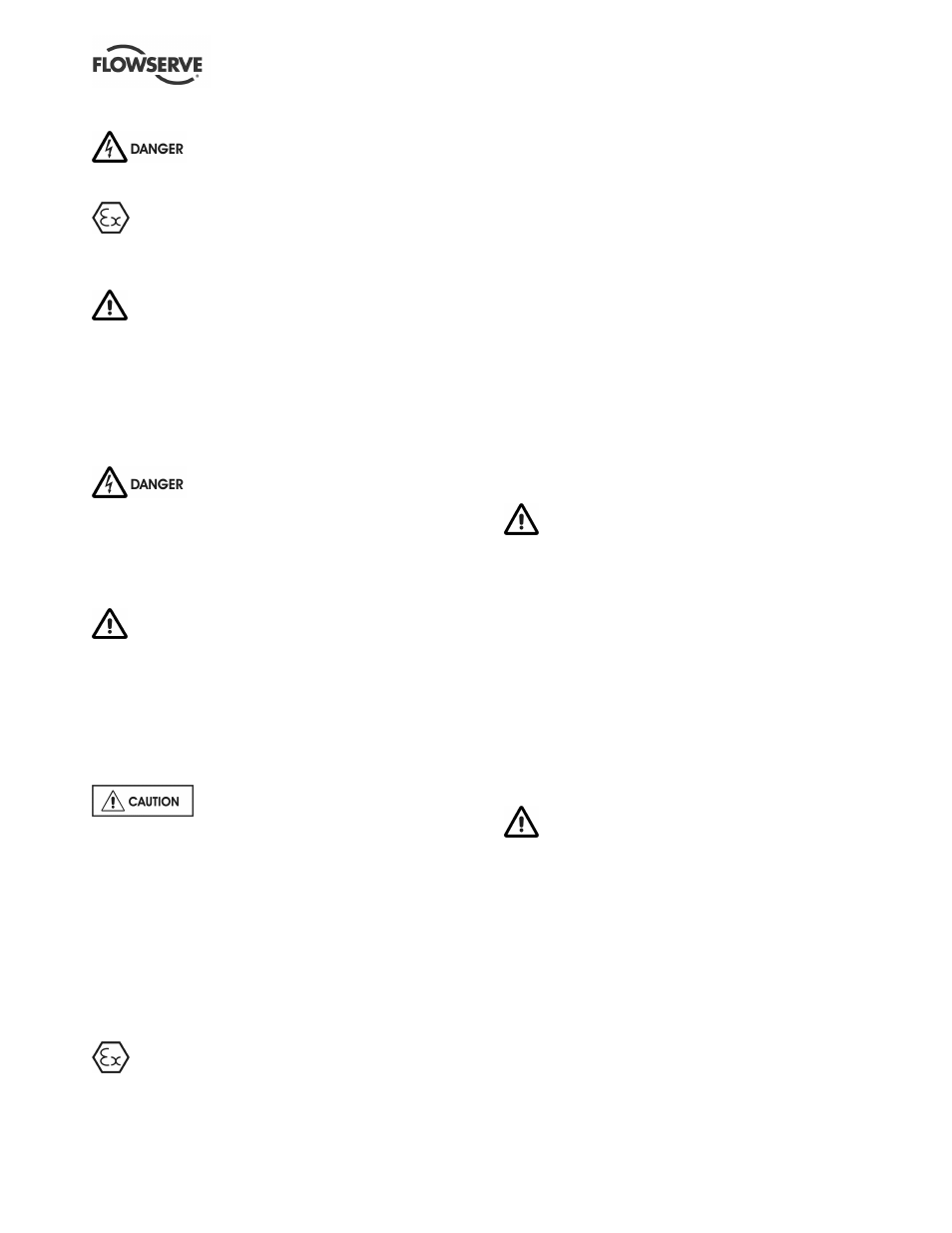Flowserve CPXS User Manual
Page 18

CPXS, CPXNS and CPXPS USER INSTRUCTIONS ENGLISH 71569250 07-11
Page 18 of 48
flowserve.com
4.7 Electrical connections
Electrical connections must be made
by a qualified Electrician in accordance with
relevant local national and international regulations.
It is important to be aware of the EUROPEAN
DIRECTIVE on potentially explosive areas where
compliance with IEC60079-14 is an additional
requirement for making electrical connections.
It is important to be aware of the EUROPEAN
DIRECTIVE on electromagnetic compatibility when
wiring up and installing equipment on site. Attention
must be paid to ensure that the techniques used
during wiring/installation do not increase
electromagnetic emissions or decrease the
electromagnetic immunity of the equipment, wiring or
any connected devices. If in any doubt contact
Flowserve for advice.
The motor must be wired up in
accordance with the motor manufacturer's
instructions (normally supplied within the terminal
box) including any temperature, earth leakage,
current and other protective devices as appropriate.
The identification nameplate should be checked to
ensure the power supply is appropriate.
A device to provide emergency stopping must
be fitted.
If not supplied pre-wired to the pump unit, the
controller/starter electrical details will also be
supplied within the controller/starter.
For electrical details on pump sets with controllers
see the separate wiring diagram.
See section 5.4, Direction of
rotation before connecting the motor to the
electrical supply.
4.8 Final shaft alignment check
After connecting piping to the pump, rotate the
shaft several times by hand to ensure there is no
binding and all parts are free. Recheck the
coupling alignment, as previously described, to
ensure no pipe strain. If pipe strain exists, correct
piping.
4.9 Protection systems
The following protection systems are
recommended particularly if the pump is installed in
a potentially explosive area or is handling a
hazardous liquid. If in any doubt consult
Flowserve.
If there is any possibility of the system allowing the
pump to run against a closed valve or below
minimum continuous safe flow install a protection
device to ensure the temperature of the liquid does
not rise to an unsafe level.
If there are any circumstances in which the system
can allow the pump to run dry, or start up empty, fit
a power monitor to stop the pump or prevent it from
being started. This is particularly relevant if the
pump is handling a flammable liquid.
If leakage of product from the pump or system can
cause a hazard an appropriate leakage detection
system shall be installed.
To prevent excessive surface temperatures at
bearings it is recommended that temperature or
vibration monitoring is carried out
Magnetic drive pumps are inherently safe and
are ideal for toxic, corrosive and highly volatile
liquids. However if abused and allowed to run dry,
for example, the consequences can be expensive
to repair. A few minutes dry running will cause
severe damage to the magnetic drive.
The main potential risks of failure are:
Dry running due to blocking of lubrication ports with
solids in pumped liquid.
1. Dry running due to loss of liquid to pump
suction.
2. Dry running due to impeller seizing, caused by
debris in the pump casing.
Dry running due to solidification of liquid in the
shell, eg due to poor control of temperature.
If any of these conditions occur, the system
must be switched off within one minute and the
most universal way of achieving this, for all the
above conditions, is by using a power or current
monitor fitted into the starter.
One other potential problem that can be monitored
when pumping hazardous fluids is leakage from the
shell.
In this instance the drive should be fitted with dual
containment and monitoring of the space between
the two shells can be carried out using a pressure
switch connected to either motor starter or alarm.